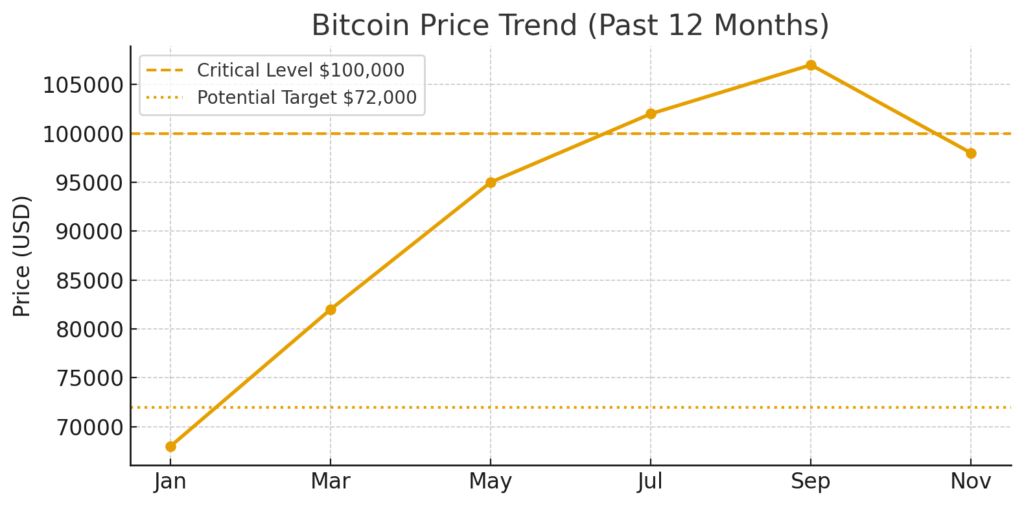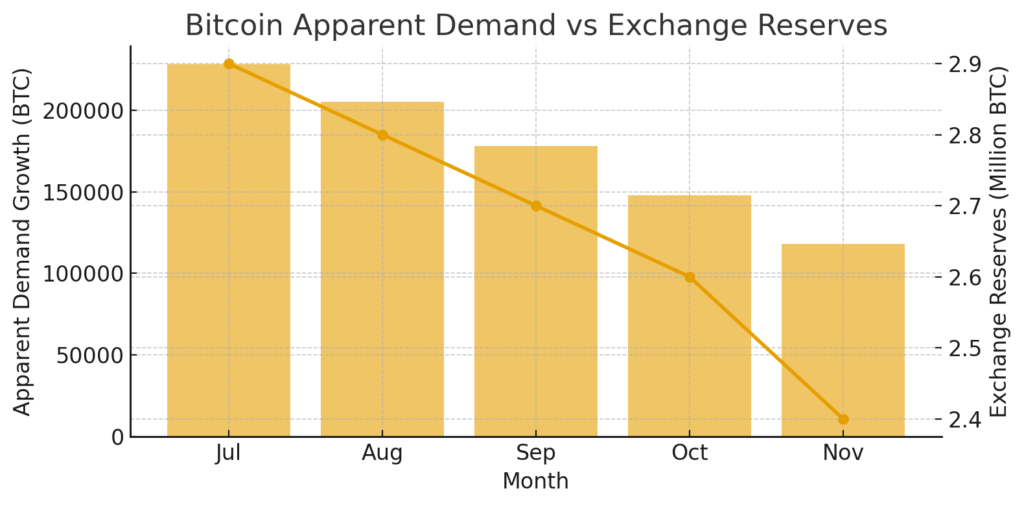
Main Points :
- The on-chain analytics firm CryptoQuant warns that if Bitcoin fails to maintain the $100,000 level, it could drop to around $72,000 over the next one to two months.
- Bitcoin recently fell below $100,000 for the first time since May; in the past 24 hours approximately ¥250 billion (~$1.6 billion) of liquidations occurred.
- CryptoQuant attributes this decline to weakening physical spot demand: negative flows from US ETFs and a negative premium on Coinbase price show waning retail/institutional appetite.
- Alternative data show other risks: ETF net flows have declined; apparent ‘real demand’ metrics are falling even as institutional accumulation continues.
- For investors seeking new crypto assets or income streams, this inflection point suggests an environment of heightened risk but also potential opportunity: if Bitcoin falters, altcoins and blockchain use-cases may benefit as liquidity searches new frontiers.
- Practical blockchain applications (e.g., decentralized finance, tokenization, non-custodial wallets) may gain relative appeal if the major asset (Bitcoin) stalls.
- In conclusion: the Bitcoin risk-reward is shifting; investors and developers alike should adapt their mindset to “what if Bitcoin corrects” and not assume only upside.
Part I: The Warning from On-Chain Analytics
Over the past week, the cryptocurrency market has been rattled by a stark message from CryptoQuant, the prominent on-chain data firm: if Bitcoin cannot hold the $100,000 threshold, a decrease toward approximately $72,000 is highly plausible within the next one to two months. The firm’s Head of Research, Julio Moreno, told the press: “If the price fails to maintain around the $100,000 region and breaks downward, then in one or two months the risk of a drop to $72,000 becomes elevated.” This comes at a time when Bitcoin’s spot demand appears to be deteriorating.
On 5 November, Bitcoin dropped below $100,000 for the first time since May, according to market data. In the preceding 24 hours, liquidations of positions equivalent to roughly ¥250 billion (~$1.6 billion) were recorded, significantly exceeding the prior day’s liquidations of around ¥169 billion.
From an investor’s standpoint, this should sound alarms: Bitcoin — often considered the anchor asset of the crypto industrial complex — is showing signs of brittle demand and susceptibility to sharp downside moves.
Why This Matters to You
If you are exploring new crypto assets or income-generating opportunities, you should not view Bitcoin’s price action in isolation. A sharp correction in Bitcoin can ripple across the broader ecosystem: new assets may either be dragged down by contagion (in which case avoid) or benefit from capital rotation (in which case you may position accordingly). Moreover, if Bitcoin’s narrative as the dominant crypto asset fails, developer interest and blockchain application focus may shift to other protocols or use-cases. Thus: watching Bitcoin’s health is not just about trading BTC itself—it is about mapping the terrain for next-generation assets and uses.
Part II: The Demand Breakdown – Spot vs Institutional Flows

CryptoQuant’s key argument is rooted in an apparent mismatch: while institutional accumulation (for example via US spot ETFs or major public companies) continues, organic spot demand appears to be weakening. Moreno notes that since the flash-crash triggered by the US tariff announcement on 11 October, spot demand has been shrinking. More specifically, ETF flows have turned negative in the United States and the Coinbase price premium has gone negative—both signals of reduced buying pressure.
In a tweet on 4 November, Moreno asked rhetorically: “Is there enough demand to absorb the supply being offered at these higher price bands? The answer has, for several weeks, been ‘no’. That is why the price is dropping.” Concurrently, CryptoQuant’s Bull Score Index (a proprietary “bull vs bear” gauge) has fallen to 20, clearly placing it in the bearish zone.
Expanding the lens, other on-chain data paint a similar picture:
- According to CryptoQuant’s “apparent demand” metric, Bitcoin’s demand growth over a 30-day window has fallen to 118,000 BTC, down from 228,000 BTC a month earlier.
- A summary article notes that despite institutional buys (e.g., 377,000 BTC via US spot ETFs; 371,000 BTC by MicroStrategy), apparent demand has contracted by ~857,000 BTC.
- Exchange reserves of Bitcoin have dropped to ~2.4 million BTC—the lowest in several years—indicating less supply available for trading or liquidation, which can act either as bullish (scarcity) or bearish (if demand doesn’t meet).
- A trading news piece puts the net demand contraction in a recent 30-day window at ~895,000 BTC, highlighting that institutional buying alone cannot offset broader weakening.
Implications for New Asset Seekers
For someone looking at new crypto projects or blockchain utility plays: the weakening of spot demand for Bitcoin suggests two paths:
- Risk scenario: If Bitcoin falls substantially, liquidity might dry up across the board—meaning smaller projects may struggle with funding, token issuance, or investor interest.
- Opportunity scenario: A Bitcoin slowdown may redirect capital toward altcoins or application layer protocols where utility or innovation is clearer—especially those offering income streams (staking, DeFi yield) or practical blockchain uses (tokenization, real-world assets). The key is to focus on protocols that are not merely pegged to Bitcoin’s momentum but have independent value drivers.
Part III: Macro & Trade-Flow Context

Beyond on-chain data, the macroeconomic and geopolitical landscape provides further texture to the risk. According to the article:
- The macro backdrop includes weakening expectation of a December interest-rate cut by the Federal Reserve, where Chairman Jerome Powell recently said a cut is not a given. The Fed had just cut by 0.25% but indicated divergence among policy-makers.
- On the trade front, there is potential progress in the US-China trade relationship: China signalled it may postpone export controls on rare earths for one year while committing to large purchases of US agricultural products. This move may reduce geopolitical risk Premiums.
- Yet, despite these theoretical tailwinds, the Bitcoin spot demand story remains weak, highlighting that macro-improvements alone are not enough in the absence of robust demand.
Why Developers & Investors Should Care
If macro risk recedes (trade deals, rate cuts), one might expect risk assets—including crypto—to benefit. However, if foundational demand is weak—or worse, declining—then even favourable macro may not trigger a full recovery. For developers building blockchain infrastructure or launching tokens, it means that market timing and ecosystem strength matter. Launching a token or application in a faltering environment may face adoption headwinds… whereas certain architectures (e.g., protocols with clear use-cases beyond speculation) might gain traction as capital becomes selective.
Part IV: Practical Implications for Blockchain Usage and New Assets
Given the scenario painted—Bitcoin at risk of a major downside, demand fatigue setting in—what are the actionable take-aways for those seeking new assets or real-world blockchain applications?
1. Re-index your risk assumption
Don’t assume Bitcoin will continue as the leading asset driver. Instead ask: What if Bitcoin corrects 20 % – 30 %? In such a scenario, where does capital go? Likely into assets that offer:
- Yield/income (staking, DeFi platforms)
- Real-world blockchain utility (tokenised real-world assets, supply-chain solutions)
- Alternative chains with differentiated narrative (layer 1s/2s with strong developer ecosystems)
If you are developing a wallet, infrastructure or token (for example your “dzilla Wallet”), this climate suggests drilling deeper into real-world use-cases and utility rather than relying solely on bullish Bitcoin momentum.
2. Focus on tokens with independent demand drivers
If demand for Bitcoin is drying up, you want to invest or develop in tokens where:
- There is active user adoption (not just speculative buying)
- There is real application (payments, tokenisation, gameFi, DeFi)
- There is income generation (yield, staking rewards, network fees)
Projects that are simply “altcoins riding Bitcoin’s wave” may suffer if Bitcoin stumbles.
3. Timing token issuance carefully
In your upcoming ICO/presale, remember: raising funds or distributing tokens when the market is leaning risk‐off will require stronger fundamentals, clearer messaging, and possibly more incentives. Given the weakening of Bitcoin demand, your marketing may need to emphasise utility, adoption, tokenomics, partnerships, real-world use rather than just “crypto hype”.
4. Monitor leading indicators
Beyond price, monitor on-chain metrics that signal demand breadth, such as:
- Active addresses growth
- Exchange net-outflows
- Realised cap of short-term holders
- Spot ETF flows
These may provide early signals of stress or opportunity beyond the headline price.
Part V: Scenario Mapping – How the Next 1–2 Months Could Play Out
Scenario A: Bitcoin Holds Above $100,000 and Recovers
If Bitcoin manages to stabilise above $100,000, recovers demand (spot flows pick up), then risk aversion may decline. In this scenario:
- Broad crypto markets could rally, boosting altcoins and blockchain applications.
- Tokens with utility and income features may take the lead as capital becomes more adventurous.
- Your timing of launches, integrations, wallet features, tokenomics may benefit from tailwinds.
Scenario B (Higher Probability per CryptoQuant): Bitcoin Breaks Below $100,000 → Moves Toward $72,000
Per CryptoQuant’s warning, this is the scenario to take seriously. In this case:
- Market sentiment will sour, risk assets will face headwinds.
- Liquidity may drain from smaller projects, fundraising might get harder.
- However: capital may rotate into distinctly promising assets rather than “Bitcoin copycats”. Projects building applications, infrastructure, real-world integration may stand out.
- For you, this means: if you’re preparing a token issuance or product launch, you may want to emphasise utility, perhaps delay until clearer market recovery OR use the quieter phase to build fundamentals and get ahead of the competition.
Scenario C: Bitcoin Slides but Macro/Utility Driven Assets Diverge
Even if Bitcoin drops, a bifurcation may occur: strong projects may decouple. This may be the most interesting for crypto-asset hunters: rather than following Bitcoin’s every move, you seek divergences: assets that gain or maintain value while Bitcoin stumbles—often because their use-case is less dependent on crypto-market sentiment and more on real-world adoption.
Conclusion
We stand at a pivotal moment in the crypto industry. The flagship asset, Bitcoin, is flashing warning signs: if the $100,000 level cannot hold, a drop toward $72,000 looms. On-chain data from CryptoQuant show that while institutional accumulation continues, spot demand is drying, broad participation is weakening, and the risk of a sharp correction is elevated. For anyone seeking the next crypto asset opportunity, or building a blockchain ecosystem (such as your dzilla Wallet), this means shifting risk assumptions: it is no longer safe to assume only upside.
Instead, orient your strategy around utility, independent demand, income generation, and application strength. Use this quieter phase (should a correction come) to build foundations, refine tokenomics, design minimal-code SNS/Telegram integrations, focus on real-world use-cases, and select projects less tethered to Bitcoin’s mood swings.
In short: the next leg of crypto isn’t guaranteed; it will be earned. If Bitcoin falters, the capital hungry for returns will hunt the next story. Make sure you are part of that story, or better—lead it.

